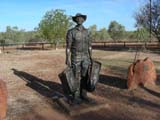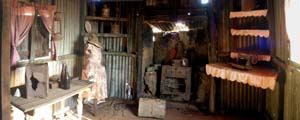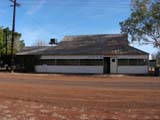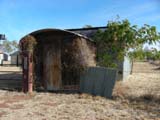 |
Droving cattle is a job which requires tenacity and skill.
It may not have been as romantic as the songs and poems relate but it is certainly
an important part of Australia's heritage.
In the Territory most of the droving was done in the Dry
season and toward the end of a season a well-used route would
become a dust bowl.
"In the (Dry) the Murranji is bulldust - just dry, dry as dry and thick.
But in the Wet it's a bath.
You can bog a mule or horse right up to its bloody withers then".
(Dick Scobie)
Many of the men and women were "loners" who for various
reasons did not like town life.
Others were born and bred in the bush.
Aboriginal people also took a strong role in the industry and were renowned
for their skills. |
 |
The drovers routine was standard.
At first light the cook
would prepare a breakfast of tea and damper and set out
extra food for the drovers to take
in their saddle
bags.
The cook would move ahead, stopping to set up the billy for lunch-time
tea, and then again to the overnight camp.
The main meal consisted of meat,
onions, potatoes, and tinned or dried vegetables.
Curry and spices masked
stale ingredients
or mistakes.
Jam was the main sweet.
A watch had to be kept over the cattle at night - a rush
was the thing most feared by drovers.
"... . when a mob go, they go BANG!! that's it, and you was dead asleep
and you'd just jump straight out, no boots, straight onto the night horse and
you're gone".
(Scotty Watson) |
 |
It was the drover's job to try and turn the cattle into
a circle and let them run themselves out. However chasing
cattle through lancewood scrub in the dark was particularly
dangerous. Although every drover had a night horse trained
to avoid scrub while at a gallop, the brittle lancewood could
still prove fatal.
After weeks on a dusty stock route a town
was a welcome break and at Newcastle Waters stores could
be replenished, telegraphic
communication with owners could
be made and, most importantly, a drink or two could be had at the Junction Hotel.
All good boss drovers ran "dry camps" so the Junction Hotel had great
appeal. Rum and beer were the standard drinks; a favourite was a mix called "Rankine
Bomb" an 8 oz glass almost filled with neat rum and topped off with port
as a sweetener.
Drovers who were the best of mates while walking cattle could engage in drunken
fights only to make up the next day.
The one policeman at Newcastle Waters did
well to keep clear of large brawls.
Grog was a part of the tradition but understandably
so after weeks of up to 14 hours a day on horseback in thick dust. |
The Town
In 1930 the government resumed one square mile from Newcastle Waters station
for a town site.
However some structures already existed, the oldest being the 1914 police station
- which was south of the present school.
Works Department had also established a depot and accommodation to the south
of the police.
None of these structures remains.



One of the earliest surviving structures is Jones' Store/George Man Fong's
house.
The lot was first leased in 1934 but no improvements were made until the
lease was transferred to Alfred Ulyatt in late 1935.
He built the central core of the present building and intended to operate a
store.
However, he obviously changed his plans very quickly as the lease was transferred
to Arnold "Jock" Jones on 6 January 1936.
Jock and his wife and family lived in and operated a business from the building
until 1949.
They added to the structure and built the bread oven at the rear.
The business was diverse - store, bakery, butcher's shop, petrol outlet.
Jock also made deliveries in his truck and was very well-liked in the wider
community.
The family also helped many a drover down on his luck.
After the Joneses left in 1949, Charles and Charlotte MacKenzie continued
the trade until 1953 at which time Archie Rogers took over the premises.




Archie was a saddler - there was no longer a need for a general store in
Newcastle Waters.
He ran his business from the old house until 1959 at which time George Man Fong
and Bill Mathews took over the lease.
Bill moved on fairly quickly but George, who had been a boss driver worked as
a saddler from the premises until 1985.
Warren Mungatroyd, a policeman stationed at Elliot became interested in
the heritage value of the property and actually purchased the lease after
George moved to Katherine.
The National Trust had been involved in discussions with Warren but had also
undertaken a major survey of the old township from which was gained a greater
insight into its significance.
The Trust subsequently took an opportunity to purchase the property from Warren.
An application to the Australian Bicentennial Authority for funds to restore
the property was successful and an official opening took place on 17 September
1988.
Mr Peter Jones, Jock Jones' son has renewed his interest in his family's heritage
and was present to unveil the plaque.
The adjacent store in similar style was
built in the early 1950's.
When Max Schober moved his business to Elliot in the late 1950's the Junction
Hotel was reduced to a bottle licence.
It totally closed in the 1960's.



The Newcastle Waters, or Junction Hotel and store remain as two of the town's
most interesting structures.
The hotel was established by local storekeeper, Jack Sargent, in 1931. It became
a popular stop for drovers and travellers for many years.
Jack gathered a group of his debtors and had them build the hotel of scrap
materials salvaged from the area, including parts from abandoned wind mills
at stock route bores.
The finished product was considered a fair exchange by all concerned. Jack
had his hotel, the debtors had their "slates" wiped clean and the
drovers had a "proper" watering hole.
A liquor licence was granted in 1932.
Shortly after Max Schober took over the management of the hotel but mainly
worked at his store across the road.
The slab of Max Schober's store remains
on the western side of the road, it being the only building erected on that
side because of flooding.
An employee by the name of Harry worked
at the pub.
Harry had his own method for serving beer, which was kept cool in wet straw.
Sober customers received cold beer but as they became less sober they were
given warmer beer - thus Harry saved his limited cold stock for customers who
could tell the difference.
Max would drive hundreds of kilometres by wagon, and later by motor vehicle,
to meet the incoming drovers and their plants to distribute supplies, often
on credit.
Another character, Harry "Bulwaddy" Bates would ride the thirty miles
from Beetaloo for a tot. Here he would hitch his horse and sit at the bar with
his rum or whisky.
Dutch born Oscar Shank took over the pub from Max in 1955.
It was said he could cook up a meal comparable to a top Sydney restaurant, but
his opinion of local tastes was to the point: "All they want is steak
and eggs, steak and eggs."
Oscar continued trading even in the face of dwindling custom until the licence
was transferred to the township of Elliott in 1962.
The Junction operated under a bottle licence until the 1970s when it was closed
down by Newcastle Waters Station owner and Territory identity, Roy Edwards.
The Junction Hotel was an important part of the Newcastle Waters township
which was situated on the top of a rise on an ironstone ridge.
It marked the end of the infamous Murranji stock route and was at the junction
of west to east and north to south droving routes. It was the start of the
next stage into Queensland.
Most of the droving was done in the dry season and at the start of the
wet there could be up to fifteen droving plants camped around the ridge.
At that time of the year there were no cattle to look after and no worries
for the drovers. And that was when most of the drinking was done at the Junction,
as most boss drovers ran dry camps during drives.


The realignment of the Stuart Highway away from Newcastle Waters, the advent
of road trains and a dramatic decrease in the movement of stock on foot spelled
the end of the township, and the junction.
From 77 000 head overlanded on the Murranji in 1951, numbers dwindled to 6 000
in four mobs in 1971.
By the mid 1970s not a single drover was operating with horses over long distances
in the Top End.
A pub that existed to cater for the overlanders could not survive the eclipse
of the horse borne drover, and the junction Hotel closed down.



It did, however, reopen briefly in 1988 for the last Great Cattle Drive,
when boss drover Noel "Pic" Willetts and his men drove a mob of 1 200
head from Newcastle Waters to Longreach in Queensland.
Other interesting structures in the town include the Telecom Repeater Station
and residence, both built in 1942.





Fred Taylor's house should also be noted.
Fred built the house himself in the 1950's.
The church is a Sydney Williams structure erected in 1962 by the Aboriginal
Inland Mission.
It is still occasionally used.
Newcastle Waters township was economically reliant on droving and kept
going into the 1960's although the Stuart Highway was realigned during World
War II. The town of Elliot gained in importance as Newcastle Waters became
a virtual ghost town.
The Aerodrome


Ross and Keith Smith's flight from England to Australia in 1919 required a number
of strips for refuelling.
The schedule included Darwin, Katherine, Newcastle Waters and thence on to Queensland.
A ground crew, under the leadership of Hudson Fysh, was employed to organise
the logistics. Fysh later wrote,
"At Newcastle Waters (we) made history by getting work started on North
Australia's first cleared aerodrome ..."
Other pioneer aviators also used this small strip cleared by Aboriginal
workers, and in 1928 and 1935 the aerodrome was upgraded.
By 1935 Qantas Empire Air Service was using the Newcastle Waters strip as a
vital link in its mail and passenger run.
The improvements were not sufficient, particularly in the Wet and in March
1936 a Qantas aircraft broke through the runway and sank two feet.
A further contract was subsequently let to resurface the strip with ant
bed and gravel.
As a watercourse passed beneath the runaway. problems continued and Qantas
pilots were complaining of ridges on the surface by 1937.
Numerous methods
were tried to improve the surface but none was successful and Qantas stopped
using the strip in November 1937.
|